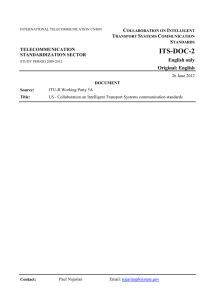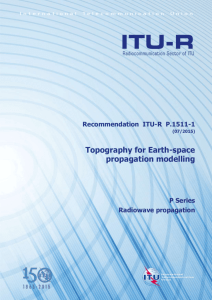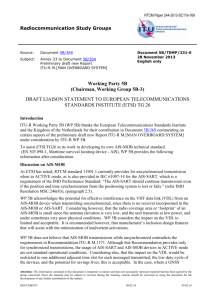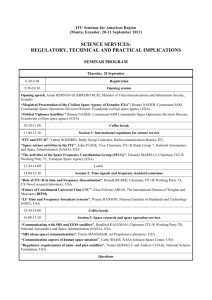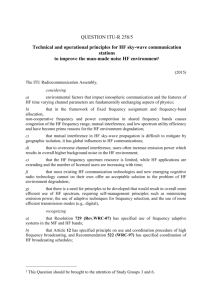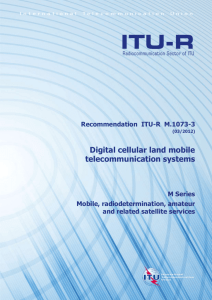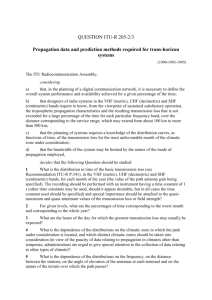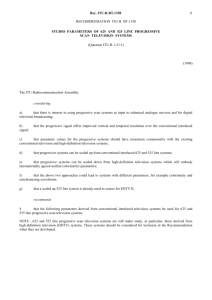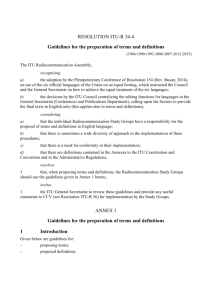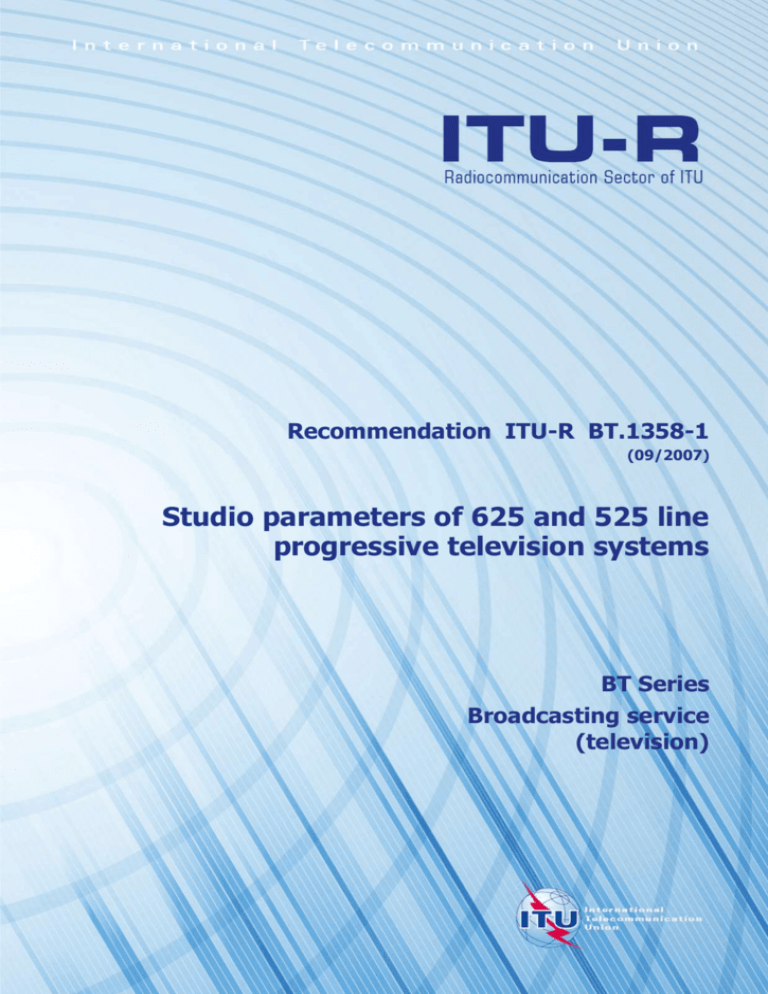
Recommendation ITU-R BT.1358-1
(09/2007)
Studio parameters of 625 and 525 line
progressive television systems
BT Series
Broadcasting service
(television)
ii
Rec. ITU-R BT. 1358-1
Foreword
The role of the Radiocommunication Sector is to ensure the rational, equitable, efficient and economical use of the
radio-frequency spectrum by all radiocommunication services, including satellite services, and carry out studies without
limit of frequency range on the basis of which Recommendations are adopted.
The regulatory and policy functions of the Radiocommunication Sector are performed by World and Regional
Radiocommunication Conferences and Radiocommunication Assemblies supported by Study Groups.
Policy on Intellectual Property Right (IPR)
ITU-R policy on IPR is described in the Common Patent Policy for ITU-T/ITU-R/ISO/IEC referenced in Annex 1 of
Resolution ITU-R 1. Forms to be used for the submission of patent statements and licensing declarations by patent
holders are available from http://www.itu.int/ITU-R/go/patents/en where the Guidelines for Implementation of the
Common Patent Policy for ITU-T/ITU-R/ISO/IEC and the ITU-R patent information database can also be found.
Series of ITU-R Recommendations
(Also available online at http://www.itu.int/publ/R-REC/en)
Series
BO
BR
BS
BT
F
M
P
RA
RS
S
SA
SF
SM
SNG
TF
V
Title
Satellite delivery
Recording for production, archival and play-out; film for television
Broadcasting service (sound)
Broadcasting service (television)
Fixed service
Mobile, radiodetermination, amateur and related satellite services
Radiowave propagation
Radio astronomy
Remote sensing systems
Fixed-satellite service
Space applications and meteorology
Frequency sharing and coordination between fixed-satellite and fixed service systems
Spectrum management
Satellite news gathering
Time signals and frequency standards emissions
Vocabulary and related subjects
Note: This ITU-R Recommendation was approved in English under the procedure detailed in Resolution ITU-R 1.
Electronic Publication
Geneva, 2010
ITU 2010
All rights reserved. No part of this publication may be reproduced, by any means whatsoever, without written permission of ITU.
Rec. ITU-R BT. 1358-1
1
RECOMMENDATION ITU-R BT. 1358-1
Studio parameters of 625 and 525 line progressive television systems
(Question ITU-R 1/6)
(1998-2007)
Scope
This Recommendation defines the signal parameters for 625 and 525 line progressive systems. Commonality
with Recommendation ITU-R BT.601 signal parameters is maintained through some direct references.
The ITU Radiocommunication Assembly,
considering
a)
that progressive scan systems have been applied to enhanced analogue services and for
digital television broadcasting;
b)
that the progressive signal offers improved vertical and temporal resolution over the
525/625 line interlaced Standard Definition Television1 (SDTV) signal;
c)
that parameter values for the progressive systems should have maximum commonality with
the existing SDTV and High-Definition Television2 (HDTV) systems;
d)
that progressive systems can be scaled up from SDTV interlaced 625 and 525 line systems;
e)
that 625 and 525 line progressive systems can be scaled down from high-definition
television systems which will embody internationally agreed unified colorimetric parameters;
f)
that the above two approaches could lead to systems with different parameters, for example
colorimetry and synchronizing waveforms,
recommends
1
that the following parameters derived from interlaced SDTV systems should be used for
SDTV 625 and 525 line progressive television systems.
Radiocommunication Study Group 6 made editorial amendments to this Recommendation in
November 2009 and May 2012 in accordance with Resolution ITU-R 1.
Future use of this Recommendation for programme production is not encouraged.
1
SDTV in the context of this Recommendation is as defined by Recommendation ITU-R BT.601.
2
HDTV is as defined in Recommendation ITU-R BT.709.
2
Rec. ITU-R BT. 1358-1
Annex 1
Signal parameter values for 625/50/P and 525/59.94/P SDTV progressive
systems derived from interlaced SDTV 625 and 525 line standards
1
Opto-electronic conversion
Characteristics
Item
Parameter
625/50/P
525/59.94/P
1.1
Chromaticity coordinates, CIE 1931(1)
See Recommendation ITU-R BT.601 § 3.6.1
1.2
Assumed chromaticity for equal
primary signals - Reference white
See Recommendation ITU-R BT.601 § 3.6.2
ER EG EB
(1)
1.3
Opto-electronic transfer characteristics before
non-linear precorrection
See Recommendation ITU-R BT.601 § 3.6.3
1.4
Overall opto-electronic transfer characteristic at
source
See Recommendation ITU-R BT.601 § 3.6.4
Chromaticity coordinates specified are those currently used by 625-line and 525-line interlaced SDTV systems.
NOTE 1 – See Recommendation ITU-R BT.1361 – Worldwide unified colorimetry and related
characteristics of future television and imaging systems.
2
Picture and scanning characteristics
Characteristics
Item
(1)
Parameter
625/50/P
525/59.94/P
2.1
Order of scanning
Left to right, top to bottom
2.2
Scanning format
2.3
Picture rate (Hz)
50
60/1.001
2.4
Total number of lines
625
525
2.5
Active lines per picture
576 (lines 45 - 620)
483 (line 43 - 525)
2.6
Aspect ratio(1)
2.7
Line frequency (Hz)
Progressive
16:9 (4:3)
31 250 0.0001%
31 500/1.001 3 ppm
The aspect ratio for HDTV applications will normally be 16:9. It is possible that SDTV progressive systems will have an aspect
ratio of 16:9 or 4:3. Parameters for such systems are contained within standard parenthesis, i.e. (4:3).
Rec. ITU-R BT. 1358-1
3
3
Analogue representation
The terms ER , EG , EB , EY , EP B (or EC B ), EP R (or EC R ) refer to gamma pre-corrected analogue signals.
Levels are specified in millivolts measured across a matched 75 termination.
Characteristics
Item
3.1
Parameter
625/50/P
Primary signals nominal level,
Standard colorimetry,
525/59.94/P
Reference black: 0%, 0 mV
Reference peak level: 100%, 700 mV
, EB :
ER , EG
3.2
Derivation of luminance component signal EY (1)
3.3
Derivation of colour-difference component signals
0.114 EB
EY 0.299 ER 0.587 EG
EP R
3.4
Component signals nominal level,
Standard and extended colorimetry,
Luminance EY :
Colour difference EP B , EP R :
3.5
Reference black: 0%, 0 mV
Reference White: 100%, 700 mV
No signal: 0%, 0 mV
Maximum colour difference: 50%, 350 mV
Maximum signal bandwidth
, EB , EY
ER , EG
EP , EP
B
R
3.6
Form of synchronizing signal on primary and
component signals(2)
3.7
Horizontal sync timing reference
3.8
Sync level (mV)
3.9
Inter-component timing accuracy
3.10
Horizontal sync and blanking interval signal timing
3.11
Vertical sync and blanking interval signal timing
EB EY
1.772
0.500 EB
0.169 ER 0.331 EG
E EY
R
1.402
0.081 EB
0.500 ER 0.419 EG
EP B
EP B EP R (1)
12 MHz
6 MHz
Bi-level bipolar (Fig. 1)
OH (Fig. 1)
–300 7.5 mV
10 ns
Fig. 1 and Table 1
Fig. 2 and Tables 2 and 3
(1)
The luminance and colour difference encoding equations used here are equivalent to those used in Recommendation ITU-R
BT.601.
(2)
Addition of synchronizing signal on R, B, PB and PR signals is optional.
4
Rec. ITU-R BT. 1358-1
FIGURE 1
Analogue horizontal synchronizing pulse
TABLE 1
Details of analogue horizontal synchronizing signals
Symbol
Characteristics
H
Nominal line period (s)
a
Horizontal blanking interval (s)
625/50/P
525/59.94/P
32
1001/31.5 (31.778)
6.0 1.5
5.35 0.15
– 0.1
b
Interval between time datum, OH, and back edge of horizontal blanking
pulse (s)
5.25
4.6 0.1
– 0.05
c
Front porch (s)
0.75 0.15
0.75 0.05
d
Synchronizing pulse (s)
2.35 0.1
2.35 0.05
e
Build-up time (10 to 90%) of the edges of the horizontal blanking pulse
(s)
0.15 0.05
0.07 0.01
f
Build-up time (10 to 90%) of the edges of the horizontal synchronizing
pulses (s)
0.1 0.05
0.07 0.01
Rec. ITU-R BT. 1358-1
5
FIGURE 2
Analogue vertical synchronizing pulses
TABLE 2
Details of analogue vertical synchronizing signals
Symbol
(1)
Characteristics
625/50/P
525/59.94/P
20
1001/60 (16.683)
V
Nominal frame period (ms)
D
Vertical blanking interval
49H + a(1)
42H + a(1)
–
Build-up time (10 to 90%) of the edges of vertical blanking pulse (s)
0.15 0.05
0.07 0.01
A
Interval between front edge of vertical blanking interval and front edge of
first vertical synchronizing pulse
5H(1)
6H(1)
C
Interval between back edge of last vertical synchronizing pulse and back
edge of vertical blanking interval
39H(1)
30H(1)
B
Duration of sequence of vertical synchronizing pulses
5H(1)
6H(1)
p
Duration of vertical synchronizing pulse (s)
29.65 0.1
29.428 0.05
r
Interval between vertical synchronizing pulse (s)
2.35 0.1
2.35 0.05
s
Build-up time (10 to 90%) of the vertical synchronizing pulses (s)
0.1 0.05
0.07 0.01
For H and a, see Table 1.
6
Rec. ITU-R BT. 1358-1
TABLE 3
Vertical blanking interval line numbers
Line number
625/50/P
525/59.94/P
4
621
1
6
44
1
7
13
42
Digital representation
The terms R, G, B, Y, CB, CR, refer to quantized and digitally encoded signals. These signals are
obtained from gamma pre-corrected signals.
The digital representation in the following table follows Recommendation ITU-R BT.601 which
defines the 4:2:2 and 4:4:4; family of 13.5 MHz sampled signals for 4:3 and for wide-screen 16:9
aspect ratio systems.
Characteristics
Item
4.1
Coded signal
4.2
Sampling lattice R, G, B, Y
4.3
Sampling lattice CB, CR,
4.4
Sampling frequency R, G, B, Y
Sampling frequency CB, CR,
4.5
Number of samples per full line
R, G, B, Y
CB, CR
4.6
625/50/P
525/59.94/P
R, G, B, or Y, CB, CR
Orthogonal, line and picture repetitive
Orthogonal, line and picture repetitive, co-sited with odd (1st, 3rd,
5th, etc.) Y active samples in each line
27 MHz 3 ppm
Half luminance sampling frequency
13.5 MHz 3 ppm
864
432
Number of samples per active line
R, G, B, Y
CB, CR
858
429
720
360
4.7
Coding format
4.8
Quantization:
Primary signals R, G, B:
See Recommendation ITU-R BT.601 § 3.5.3
4.9
Quantization: Component signal Y:
Component signals CB, CR:
See Recommendation ITU-R BT.601 § 3.5.3
4.10
Derivation of Y, CB, CR from quantized
primary signals R, G, B:)
4.11
Timing relationship between analogue sync
reference, OH, and video data
4.12
Quantization level assignment:
Video data:
Timing references:
4.13
(1)
Parameter
Linear, 8 or 10 bits/sample for each primary and component signal
See Recommendation ITU-R BT.601 § 3.5.4
132 samples at 27 MHz
(Fig. 3)
Filter characteristics(1)
R, G, B, Y
CB, CR
The filter templates are shown in Fig. 4 and Fig. 5 as a guideline.
122 samples at 27 MHz
(Fig. 3)
1.00 through 254.75
0.00 to 0.75 and 255.00 to 255.75
Fig. 4
Fig. 5
Rec. ITU-R BT. 1358-1
7
FIGURE 3
Timing relationship between analogue sync reference, OH, and video data
625
OH
Digital line n – 1
12 T
717
718
719
720
721
132 T
730
731
732
733
862
863
0
1
2
359
360
365
366
431
0
1
359
360
365
366
491
0
1
525
OH
Digital line n – 1
16 T
717
718
719
720
721
122 T
734
735
736
737
856
857
0
1
2
359
360
367
368
428
0
1
359
360
367
368
428
0
1
1358-03
8
Rec. ITU-R BT. 1358-1
Rec. ITU-R BT. 1358-1
9

